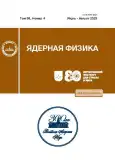Proposal and Analysis of an Experiment for Accurate Measurement of the Muon Lifetime and the Fermi Constant
- Authors: Bakalyarov A.M.1, Klimov A.I.1, Machulin I.N.1, Meleshko E.A.1, Selivanov V.I.1
-
Affiliations:
- National Research Centre Kurchatov Institute
- Issue: Vol 86, No 4 (2023)
- Pages: 485-494
- Section: ЭЛЕМЕНТАРНЫЕ ЧАСТИЦЫ И ПОЛЯ. Эксперимент
- URL: https://journals.rcsi.science/0044-0027/article/view/139747
- DOI: https://doi.org/10.31857/S0044002723040062
- EDN: https://elibrary.ru/EGDRHT
- ID: 139747
Cite item
Full Text
Abstract
An experiment is proposed for a record-breaking measurement of the world Fermi constant GF during the decay of a positive muon. All systematic errors were analyzed. The Fast Program (FP) was developed and tested using the GEANT data and running ≈1500 times faster. 1014 events were collected with two options for selecting events. An accuracy of 0.46 ps for the muon lifetime and 0.1 ppm for the GF value was obtained taking into account all systematic errors. The accuracy of the theoretical calculations of GF is 0.14 ppm within the framework of the Standard Model interactions of elementary particles
About the authors
A. M. Bakalyarov
National Research Centre Kurchatov Institute
Email: selivanov@akado.ru
Moscow, Russia
A. I. Klimov
National Research Centre Kurchatov Institute
Email: Selivanov_VI@nrcki.ru
Moscow, Russia
I. N. Machulin
National Research Centre Kurchatov Institute
Email: Selivanov_VI@nrcki.ru
Moscow, Russia
E. A. Meleshko
National Research Centre Kurchatov Institute
Email: selivanov@akado.ru
Moscow, Russia
V. I. Selivanov
National Research Centre Kurchatov Institute
Author for correspondence.
Email: selivanov@akado.ru
Moscow, Russia
References
- E. Tiesinga, P. J. Mohr, D. B. Newell, and B. N. Tay- lor, Rev. Mod. Phys. 93, 025010 (2021).
- V. Tishchenko et al. (MuLan Collab.), Phys. Rev. D 87, 052003 (2013).
- A. Pak and A. Czarnecki, Phys. Rev. Lett. 100, 241807 (2008).
- A. Crivellin, M. Hoferichter, and C. A. Manzari, Phys. Rev. Lett. 127, 071801 (2021).
- V. Tishchenko, S. Battu, R. M. Carey, D. B. Chit- wood, J. Crnkovic, P. T. Debevec, S. Dhamija, W. Earle, A. Gafarov, K. Giovanetti, T. P. Gorringe, F. E. Gray, Z. Hartwig, D. W. Hertzog, B. Johnson, P. Kammel, et al., arXiv: 1211.0960v1 [hep-ex].
- https://www.onsemi.com/products/sensors/silicon-photomultipliers-sipm
- Y. Shao, Phys. Med. Biol. 52, 1103 (2007).
- https://www.caen.it/products/
- J. Allison, K. Amako, J. Apostolakis, P. Arce, M. Asai, T. Aso, E. Bagli, A. Bagulya, S. Banerjee, G. Barrand, B. R. Beck, A. G. Bogdanov, D. Brandt, J. M. C. Brown, H. Burkhardt, Ph. Canal, et al., Nucl. Instrum. Methods Phys. Res. А 835, 186 (2016).
- S. Liao, R. Erasmus, H. Jivan, C. Pelwan, G. Peters, and E. Sideras-Haddad, J. Phys.: Conf. Ser. 645, 012021 (2015).
- S. Sánchez Majos, P. Achenbach, and J. Pocho- dazalla, Nucl. Instrum. Methods Phys. Res. A 594, 351 (2008).
- https://www.psi.ch/en/smus/pie3
- G. G. Myasishcheva, Yu. V. Obukhov, V. S. Roganov, and V. G. Firsov, Zh. Eksp. Teor. Fiz. 56, 1199 (1969).
- M. Renschler, W. Painter, F. Bisconti, A. Haungs, T. Huber, M. Karus, H. Schieler, and A. Weindl, arXiv: 1804.00897v1 [astro-ph.IM].
- T. Prokscha, Isis Muon Training Course, 25th-Feb-2005, https://www.psi.ch/en
- B. Markovic, D. Tamborini, S. Bellisai, A. Bassi, A. Pifferi, F. Villa, G. M. Padovini, and A. Tosi, in Proceedings of SPIE, 2013, San Francisco, California, United States, Vol. 8631, 86311Fhttps://doi.org/10.1117/12.2005537
- T. Prokscha, E. Morenzoni, K. Deiters, F. Foroughi, D. George, R. Kobler, A. Suter, and V. Vrankovic, Nucl. Instrum. Methods Phys. Res. A 595, 317 (2008).
- A. U. Abeysekara, R. Alfaro, C. Alvarez, J. D. Ál- varez, R. Arceo, J. C. Arteaga-Velázquez, H. A. Ayala Solares, A. S. Barber, B. M. Baughman, N. Bautista-Elivar, J. Becerra Gonzalez, E. Belmont-Moreno, S. Y. BenZvi, D. Berley, M. Bonilla Rosales, J. Braun, et al., Nucl. Instrum. Methods Phys. Res. A 888, 138 (2018).
Supplementary files









